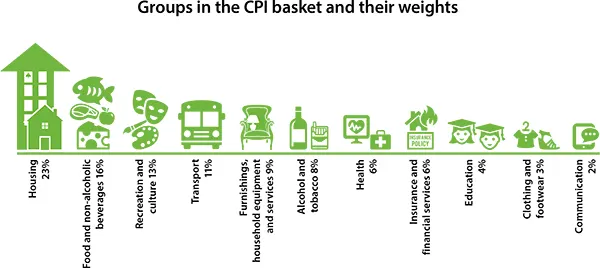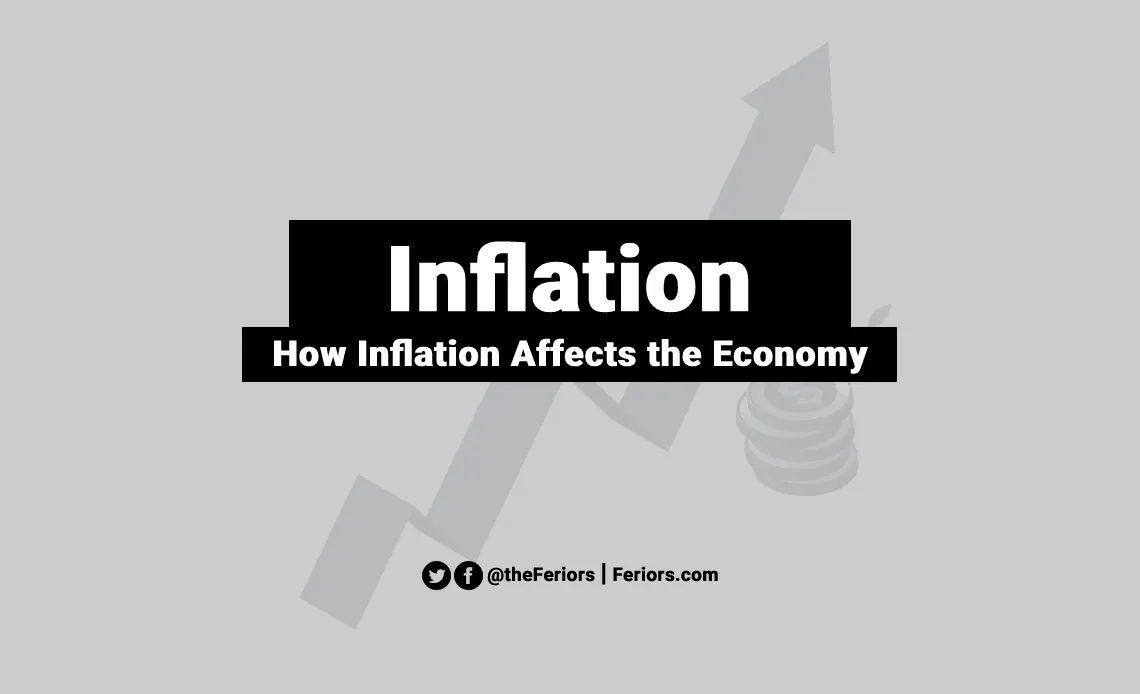What is the Inflation
Inflation is the rate at which the value of a currency decreases and hence the general level of prices for goods and services increases. Inflation is measured in different ways depending on the types of goods and services considered and is the opposite of deflation, which indicates a general decline in the prices of goods and services when the inflation rate falls below 0%.
However, inflation is a continuous increase in the price level, not just a single upward jump. Thus sustained inflation requires a continuous increase in aggregate demand. It’s important because if it continues at apparently small annual rates of change for a long time, it can cause the price level to double or triple. For instance, an annual inflation rate of 7% causes the price level to double in only five years.
A common cause of inflation is an increase in the cost of producing goods and services, which leads to higher prices. Another cause of inflation is when the demand for goods and services exceeds what can be produced at the time, causing prices to rise. Higher inflation could also stimulate spending, as consumers will be eager to buy goods quickly before their prices rise even further.
This higher price will cause only a temporary increase in the aggregate price index and measured inflation. If your income stays the same while prices rise, you will feel the effects of inflation. If inflation is supposed to collapse, there will be a sharp rise in real rates. Negative effects of inflation include the increased opportunity cost of holding money, uncertainty about future inflation that can discourage investment and saving, and if inflation is fast enough, consumers start hoarding goods due to fears of rising prices, leading to shortages. In future.
For example, when the expansion of the money supply leads to a speculative boom in the price of oil, the cost of energy for all uses rises and pushes up consumer prices, which is reflected in various inflation measures. Unsustainable economic overheating can lead not only to high inflation, but also to rising inflation, which in turn leads to increasing costs to restore price stability.
This continuous change in purchasing power and prices (called the Cantillon effect) means that the inflation process not only raises the overall price level over time, but also distorts relative prices, wages, and profit rates in the process. Annual inflation rates reflect price changes more clearly than average annual inflation rates.
There are several types of inflation that are caused by a variety of factors, including:
- Demand-pull inflation: Occurs when demand for goods and services exceeds supply, leading to an increase in prices.
- Cost-push inflation: Occurs when the cost of producing goods and services increases, leading to higher prices.
- Structural inflation: Occurs when changes in the economy’s structure, such as new regulations or changes in technology, lead to higher prices.
- Hyperinflation: Occurs when prices rise extremely quickly, often leading to a breakdown in the economy.
Demand Shock & Supply Shock
A demand shock is a sustained acceleration or deceleration in aggregate demand, measured most directly as a sustained acceleration or deceleration in the growth rate of nominal GDP. Demand inflation is inflation caused by an acceleration of the growth rate of nominal aggregate demand. Demand inflation can be caused by changes in any of the demand factors (consumer and business confidence, the money supply, real wealth, the tightness or ease of credit condition in financial markets, government spending, tax rates, transfers, and net exports.
A supply shock is caused by a sharp change in the price of an important commodity (e.g. oil) that causes the inflation rate to rise or fall in the absence of demand shocks. Supply inflation is an increase in prices that stems from an increase in business costs not directly related to a prior acceleration of nominal GDP growth.
How to Measure Inflation Rate
To measure the inflation rate, the change in prices of a large “basket” of representative goods and services is measured. Both the types of goods and services included in the basket and the weighted price used in terms of inflation will change over time to keep up with the changing market.

However, to measure inflation, you can’t just take an asset and measure how its price has changed. A common measure of inflation is the inflation rate, which is the annual percentage change in a general price index (usually the consumer price index) over time. You can calculate the inflation rate by looking at the percent change in the consumer price index over a given time period. A common measure of inflation is the Consumer Price Index, or CPI, calculated by the U.S. Bureau of Labor Statistics.
What is the Consumer Price Index (CPI)
The consumer price index (CPI) is a measure of the average change over time in the prices paid by urban consumers for a market basket of consumer goods and services. Indexes are available for the U.S. and various geographic areas. Average price data for select utility, automotive fuel, and food items are also available.
Inflation, measured by the Consumer Price Index (CPI), is defined as the change in the price of a basket of goods and services commonly purchased by certain household groups. More commonly, the term “inflation” refers to an increase in the broad price index, which is the general level of prices for goods and services in an economy. Inflation is designed to measure the aggregate impact of price changes on various products and services, and to provide a unique representation of value for the increase in the price level of goods and services in an economy over a given period. Inflation is often seen as a disorderly rise in the overall price level.
Some of these measures of core inflation suggest that noise is related to the magnitude of price changes (small and large), while others associate noise with certain goods (food and energy being the most common example). A popular approach to removing noise from price data is to remove components that are seen as a source of noise in aggregate price indices such as the CPI or the PCE price index. Core inflation is another way of referring to the component of inflation that would prevail if such limited or temporary effects could be excluded from the price data. Such limited or temporary effects are sometimes referred to as “noise” in price data because they can mask price changes that are expected to persist over a few years in the medium term: core inflation.
A significant increase in the seasonally adjusted index in the short term may indicate a period of inflation, while a significant decrease in the CPI in the short term may indicate a period of deflation. Because the CPI includes volatile food and oil prices, it is not a reliable indicator of periods of inflation and deflation. “Inflation” can also be used to describe an increase in the price level of a narrower set of goods, goods, or services in an economy, such as commodities (including food, fuel, metals), physical goods (such as real estate), and financial assets. (e.g. stocks, bonds), services (e.g. entertainment and healthcare) or jobs. As long as they remain the same, the price level will be proportional to the money supply and inversely proportional to the actual amount of production.
Is that the Inflation Good or Bad?
Inflation can be both good and bad, depending on the specific context and level of inflation.
On the positive side, moderate inflation can encourage spending and investment, as people may be more likely to buy goods and services if they believe that prices will rise in the future. In addition, inflation can help to reduce the real value of debt, which can be beneficial for borrowers. A moderate level of inflation can also help to keep nominal interest rates from falling too low, which can be helpful for the economy.
However, high or unpredictable inflation can be harmful to the economy. When inflation is too high, it can lead to a decrease in the purchasing power of money, which can hurt consumers and reduce the value of savings. This can lead to a decrease in confidence in the economy, which can have negative effects on investment and economic growth. In addition, high inflation can lead to wage-price spirals, where workers demand higher wages to keep up with rising prices, leading to further increases in inflation.
To put it simply, moderate inflation can have some benefits for the economy, but high or unpredictable inflation can be harmful. Therefore, central banks and governments often aim to maintain a moderate level of inflation to balance these competing effects.
References: Federal Reserve of Cleveland, IMF, U.S. Bureau of Labor Statistics, Reserve Bank of Australia




